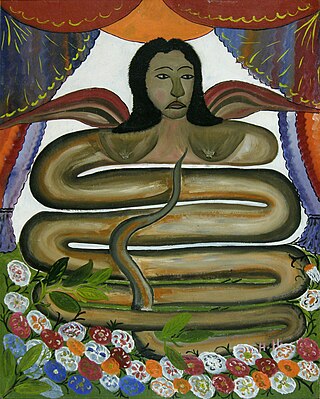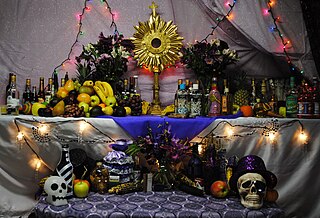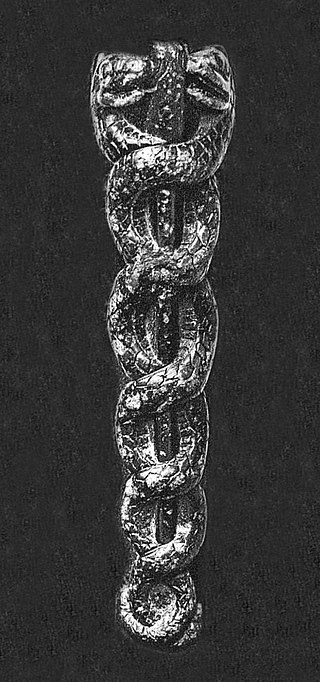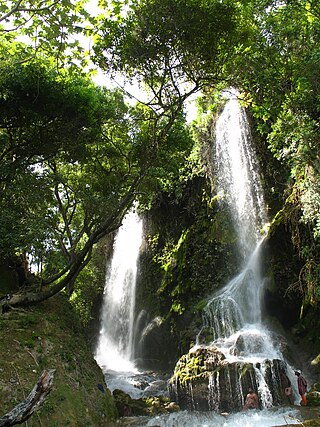
Lwa, also called loa, are spirits in the African diasporic religion of Haitian Vodou. They have also been incorporated into some revivalist forms of Louisiana Voodoo. Many of the lwa derive their identities in part from deities venerated in the traditional religions of West Africa, especially those of the Fon and Yoruba.

Vodun is a religion practiced by the Aja, Ewe, and Fon peoples of Benin, Togo, Ghana, and Nigeria.

Agassou is a loa who guards the old traditions of Dahomey in the West African Vodun religion and the rada loa of Haitian Vodou.

Damballa, also spelled Damballah, Dambala, Dambalah, among other variations, is one of the most important of all loa, spirits in Haitian Voodoo and other African diaspora religious traditions such as Obeah. He is traditionally portrayed as a great white or black serpent, but may also be depicted as a rainbow. Damballa originated in the city of Wedo in modern-day Benin.

Maman Brigitte sometimes also written as Manman Brigitte and also known by Gran Brigitte, Grann Brigitte, Manman, Manman Brigit, and Maman Brijit is a death loa and the consort of Baron Samedi in Haitian Vodou. She drinks rum infused with hot peppers and is symbolized by a black rooster. Maman Brigitte protects graves in Haitian cemeteries that are marked by the cross of Baron Samedi. Graves that are protected by Brigitte are marked by a mound of stones. In Vodou practice, the first burials serve as offerings to either Baron Samedi or Maman Brigitte depending on the gender of the person being laid to rest. If the deceased person is male then the grave is dedicated to Baron Samedi; if the deceased person is female then the grave is dedicated to Maman Brigitte.

Erzulie is a family of loa, or spirits, in Vodou.
Marassa Jumeaux are the divine twins in Vodou. They are children, but more ancient than any other loa. "Love, truth and justice. Directed by reason. Mysteries of liaison between earth and heaven and they personify astronomic-astrological learning. They synthesize the vodou Loa as personification of divine power and the human impotence. Double life, they have considerable power which allow them manage people through the stomach. They are children mysteries."
The Dahomean religion was practiced by the Fon people of the Dahomey Kingdom. The kingdom existed until 1898 in what is now the country of Benin. People taken from Dahomey to the Caribbean used elements of the religion to form Haitian Vodou and other African diasporic religions.

Nana Buluku, also known as Nana Buruku, Nana Buku or Nanan-bouclou, is the female supreme being in the West African traditional religion of the Fon people and the Ewe people (Togo). She is one of the most influential deities in West African theology, and one shared by many ethnic groups other than the Fon people, albeit with variations. For example, she is called the Nana Bukuu among the Yoruba people and the Olisabuluwa among Igbo people but described differently, with some actively worshiping her while some do not worship her and worship the gods originating from her.

A veve is a religious symbol commonly used in different branches of Vodun throughout the African diaspora, such as Haitian Vodou and Louisiana Voodoo. The veve acts as a "beacon" for the lwa, and will serve as a lwa's representation during rituals.
Mawu-Lisa is a creator goddess, associated with the Sun and Moon in Dahomey mythology. Mawu and Lisa are divine twins. According to the myths, she is married to the male god Lisa. Mawu and Lisa are the children of Nana Buluku, and are the parents of Oba Koso (Shango), known as Hebioso among the Fon.

Homosexuality in Haitian Vodou is religiously acceptable and homosexuals are allowed to participate in all religious activities. However, in West African countries with major conservative Christian and Islamic views on LGBTQ people, the attitudes towards them may be less tolerant if not openly hostile and these influences are reflected in African diaspora religions following Atlantic slave trade which includes Haitian Vodou.
Zaka is the loa of the harvest in Haitian Vodou mythology. Another way to reference this loa is through the name "Azaka Médé".

Snake worship is devotion to serpent deities. The tradition is nearly universal in ancient cultures, particularly in religion and mythology, where snakes were seen as the holders of knowledge, strength, and renewal.
The Rada are a family of lwa spirits in the religion of Haitian Vodou. They are regarded as being sweet-tempered and "cool", in this contrasting with the Petro lwa, which are regarded as volatile and "hot".
Vodou drumming and associated ceremonies are folk ritual faith system of henotheistic religion of Haitian Vodou originated and inextricable part of Haitian culture.

Saut-d'Eau is a commune in the Mirebalais Arrondissement, in the Centre department of Haiti. It has 34,885 inhabitants.
The Fon creation myth is the traditional creation story of the Fon peoples of West Africa. Various versions of the creation story are told. In most the creator is either Mawu, the moon being and mother of all the gods and humanity, or Mawu-Lisa, the sun/moon being who is both male and female. In others, Nana Buluku is the ultimate creator, an androgynous deity who gave birth to the female Mawu and the male Lisa and passed the power over creation to them.

Haitian Vodou art is art related to the Haitian Vodou religion. This religion has its roots in West African traditional religions brought to Haiti by slaves, but has assimilated elements from Europe and the Americas and continues to evolve. The most distinctive Vodou art form is the drapo Vodou, an embroidered flag often decorated with sequins or beads, but the term covers a wide range of visual art forms including paintings, embroidered clothing, clay or wooden figures, musical instruments and assemblages. Since the 1950s there has been growing demand for Vodou art by tourists and collectors.
The potomitan is an essential structural feature of the hounfour (temple) in Haitian vodou. Occupying the central position in the peristyle, the potomitan takes the form of a decorated wooden post by means of which, it is believed, the loa descend to Earth to inhabit, for a time, the bodies of the faithful through spirit possession.










